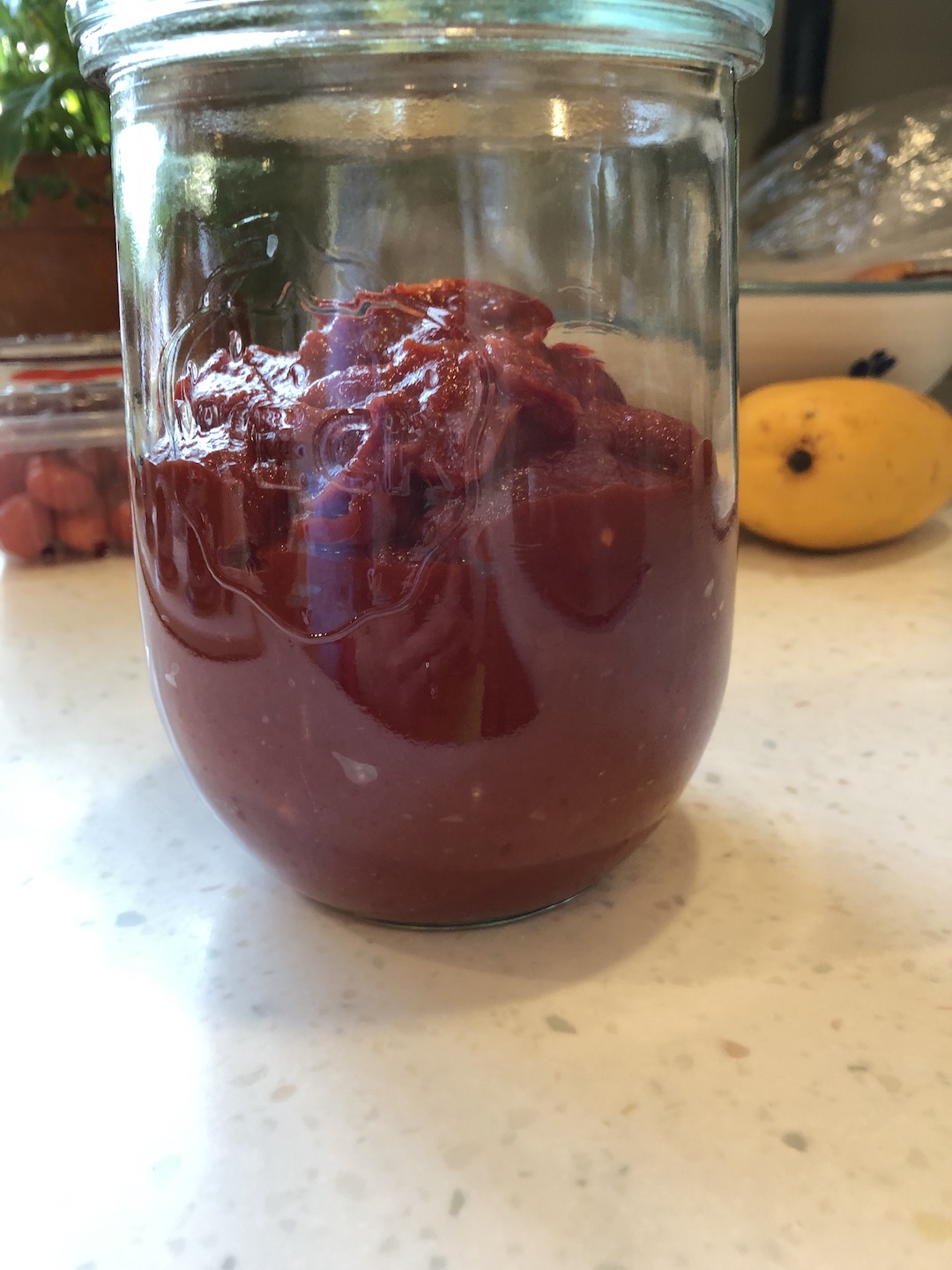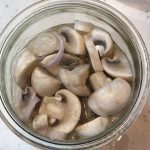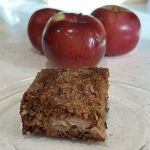
Here is the transcript of the episode:
Welcome to the sensitive kitchen where home cooks are inspired to cook to enable those you love to flourish. I’m Cindy Sullivan, registered dietitian, passionate nutrition educator, and accomplished home cook. Whether you’re changing how you cook for food sensitivities, allergies, intolerances, or just trying to eat healthier on a budget, you’re in the right place. Most episodes, I will share favorite recipes as well as modification tips and nutrition benefits. Occasionally I’ll have a guest or special episode like modifying holiday favorites. My favorite foods, they’re raspberries and homemade chocolate chip cookies. My latest cooking project was long fermented sourdough bread.
We’re here today to talk about simple fermented ketchup. Are you interested in an easy, quick way to get some more fermented food into your diet? Or perhaps add some more antioxidants? Let’s talk about fermented ketchup. I like ketchup. I can’t eat French fries, hamburgers or meatloaf without it. Ketchup has umami. The taste that adds savoriness. It has a little sweetness for my taste buds and antioxidants to keep my body healthy, a win-win, but this fermented version kicks it up a notch. The complexity of flavor adds something special to whatever you put it on.
And the salad dressing made from it has become one of our favorites. It’s a variation of a sweet sour, French dressing, but with a complexity of flavor that commercial French dressings just can’t match. If you’ve been a little afraid of fermenting foods, this is a good, easy recipe to get you started.
For our nutrition tidbits today, let’s talk about lycopene and then fermented foods.
Lycopene is that antioxidant I mentioned. Now a few of you can take a quick nap, but for those of you who want to know why cooked tomatoes are better sources of lycopene, or what to eat with lycopene in order to enhance this absorption, this three minute science lesson is for you. Lycopene is a carotinoid – the same family of compounds as beta carotene, which is the plant precursor to vitamin A, but lycopene does not have vitamin A activity. However, it’s still good for you. It acts as an antioxidant in your body. In fact, all carotinoids are antioxidants and help your body fight inflammation and oxidation. Inflammation and oxidation can increase your risk of cancer, athero sclerosis, diabetes, Alzheimer’s, Parkinson’s, aging, any process that free radicals can promote.
While beta carotene is orange in color, Lycopene gives many foods, their red color, watermelon, pink grapefruit, guava, and most famously tomatoes. Tomato products vary in the amount of lycopene they contain. And this is partially due to the concentration of lycopene in these products and how much water has been taken out. Now when contained in the raw fruits and vegetables, lycopene exists as protein lycopene complexes that are not easily absorbed, but when you cook these complexes, the lycopene from many of these bonds are released. And then the lycopene can be absorbed. Because lycopene is a carotinoid it is fat soluble. So it needs some fat for absorption. In the same meal, eat some fat.
This is not usually a problem. With pizza sauce, we eat cheese. With tomato juice, make my cabbage soup. It has a little bit of bacon in it with this. Ketchup, eat it with our favorite gluten-free meatloaf that I discussed in episode four. If you use it in my fermented ketchup salad dressing recipe, there’s fat in that recipe. Now it’s important to realize that lycopene is not the only carotinoid in tomato products. It is just the one that has been studied the most. In other words, other compounds in tomato products may also be contributing to these benefits. What does that mean? Don’t take a lycopene supplement, eat more fruits and vegetables for all their amazing benefits.
Lycopene was not the reason I started making fermented ketchup. I was trying to get more fermented food in my family’s diet. My son who was more resistant, loves sauces, including ketchup. Add more healthy bacteria to your diet without vegetables or yogurt? Are there really live active cultures in this ketchup? Yes, there are. And you’re going to use either sauerkraut “juice” or liquid or yogurt whey from unsweetened yogurt, things that are often thrown away, to make this ketchup. Let’s discuss fermented foods a minute though, before we go on and talk about this recipe.
Throughout history, fermented foods have been a staple in the diets of many cultures. From sauerkraut and kimchi to soy sauce and yogurt, traditional fermented foods can be found all around the world. However, not much was known about how they worked their magic until recently studies shown that compounds in fermented foods have anti-inflammatory and antioxidant properties and may help prevent diseases like heart attacks and cancer.
In addition, the good bacteria in the fermented foods are beneficial. They’re beneficial for those bacteria that already live in your gut. The microbiota or good bacteria that live in your gut synthesize essential compounds like vitamin K and several B vitamins. They ferment some of the soluble fiber in your diet to produce short chain fatty acids that help your body fight cancer and may help lower your cholesterol.
In addition, with a healthy colony of good bacteria, living in your gut, bad bacteria have fewer places to colonize. So if I convinced you that making this ketchup is worth the 10 minutes of your time, if you’re not a big ketchup eater, just make it for the fermented ketchup salad dressing. And besides salad, you can drizzle it over vegetables or use it as a dip.
Now let’s talk about some of the ingredients in this ketchup. Particularly first, let’s talk about the sauerkraut. You’re using sauerkraut that’s fermented, not canned. When you read the ingredient label, it should contain cabbage, salt and water. There may be other vegetables like beets or flavors like ginger. You want to avoid these perhaps until you’ve made this ketchup at least once, but that’s up to you. If the ingredient list on your sauerkraut lists vinegar, that is not one with live active cultures. You should purchase the sauerkraut in the refrigerator section of your grocery store and the price should shock you the first time you purchase it. My favorite is $9 a jar, yikes, but you’ll only eat a couple tablespoons at a time and it will make this delicious ketchup.
This ketchup will last several weeks in your refrigerator. And I would like to report it will last several months, but ours never lasts that long. Store it in a glass jar. Weck is the brand that is my choice, but any jar with a wide mouth will do. A wide mouth jar makes it easier to push down any ketchup from the sides. Every time you’re through with this ketchup, you’ll want to push or scrape down that ketchup on the sides into the remaining ketchup. It only takes 15 seconds, but it will help prolong its life so the small amounts of ketchup on the side won’t mold.
Let’s talk a little bit about substitutions. We use maple syrup in this ketchup. You can use honey or any other liquid sweetener. You probably can even use granulated white sugar, but I have not tried. It. You’ll want to add some water if you use a non-liquid sweetener.
Garlic. If you can’t use garlic, I would try shallots or onions, minced very finely.
For dairy, there is no dairy in this recipe if you use the sauerkraut starter. If you use the yogurt starter, then obviously there may be dairy in this recipe. Okay? Any other fermented vegetable juice should work here, I just haven’t tried any other ones, so you can let me know if you do.
Now, the vinegar, you can add even more probiotics if you use an apple cider vinegar with active cultures, but you can use whatever you have on hand. Distilled vinegar will work also.
This is really simple stuff to prepare. There’s no cooking involved. You’re going to chop your garlic, mix the tomato paste with the fermented liquid, either the sauerkraut juice or the whey from the yogurt and the apple cider vinegar. Add the garlic and the maple syrup and mix well. Scrape down the sides of the jar and loosely cover it. You’re then going to let the ketchup sit on your counter at room temperature, loosely covered, for three days. Then you’re going to tightly seal it and refrigerate it. And it’s time to enjoy.
Let’s talk about a few other notes about this recipe. If you’re using the sauerkraut starter, drain the liquid until you have six tablespoons. If this leaves some sauerkraut out of the brine plan to eat it today or tomorrow. If you’re using yogurt for your starter, drain the whey into a measuring cup. If you don’t have enough, you may have to drain some yogurt.
You can use a nifty yogurt strainer. I picked mine up at King Arthur catalog years ago and love it, but it only gets used a few times a year. Don’t buy one. Just for this. You can use a coffee filter or layers of cheesecloth, and a strainer. If you need to strain some yogurt, it may take an hour or so. So put it in the fridge while it strains. Be sure that the yogurt you use has live active cultures in it. I recently scolded my husband for drinking the whey: “I’m trying to make fermented ketchup with that. Don’t use it.” Poor guy, more signs in my fridge. “Don’t eat this I’m saving it.” You can also mix the starter, use some sauerkraut juice and some whey from yogurt if you don’t have enough of one for the whole recipe.
If you use a glass or metal bowl, you won’t need to worry about staining your plastic container. When you have your tomato paste in the bowl, slowly add the starter, mixing as you go until well combined. As I mentioned, I like to use a weck tulip jar. I just put the glass lid on and let it sit on my counter.
And then when I go to refrigerated, I put the gasket and the clips on for longer term refrigerated storage. As I mentioned before, before fermentation, and after using this ketcup, scrape down the sides of the container. And before you’re going to ferment it actually wipe them off, usually with a paper towel or a clean cloth.
As this ketchup sits in your refrigerator, it will get thicker and thicker. This is normal. It will get so that it’s almost chunky. If you let it sit long enough, if it gets too thick, just put some in a bowl, add some water and mix in some water to your desired consistency and serve it. It’s easy. Just add some water to it. You can customize the spices in this recipe to your family’s tastes. Try adding cinnamon, cloves, smoked paprika, or even a little mustard powder. The tweaks are easy and endless. The first time you add a spice, you might want to add it to a smaller portion, take some out, put it in a bowl, try a little bit as a taste test.
So, besides eating this ketchup straight up, you can make a complex sweet and sour, French style salad dressing with it. I wonder if your recipe box is like mine. In my recipe box, there are a few scraps of paper with recipes scrawled on them. The oldest one is from my graduate school roommate. It is her claim to culinary fame. We have used it as a sweet and sour “French” dressing for years. It serves as the basis for this recipe, but the fermented ketchup elevates this recipe to another level. The taste bud tickler is umami. Why does the fermented ketchup make such a difference? Umami and fermentation.
Umami is that meaty, brothy, complex flavor people crave. It’s why food companies and restaurants add MSG or monosodium glutamate to recipes, but there are naturally occurring sources of umami like tomatoes, mushrooms, Parmesan cheese. As I said, umami is in tomatoes, particularly concentrated tomatoes like tomato paste, fermentation, amplifies this flavor, making it more complex. It turns a good salad dressing into something company worthy. First to make this recipe you need fermented ketchup, three days waiting time here. The ingredients are simple: a third of a cup of fermented ketchup, a third of a cup of vinegar (I use just distilled vinegar in this), a quarter cup of maple syrup, a third of a cup of oil, a large clove of garlic (if you can’t have garlic, you can substitute shallots, minced) finally add two shakes of onion powder.
Basically, you’re going to just take a whisk and whisk the fermented ketchup. Now, remember I said, the fermented ketchup might get chunky. If yours has gotten a little chunky, add water to it after you’ve added the vinegar and the maple syrup, if it’s still thick, add just a little water, a couple of tablespoons of water, to it. This is a great dressing and it’s even better when it sits overnight. Enjoy!
Thank you so much for listening today. Try to add some more fermented foods to your diet. And this is a great, easy, simple thing to do. The only chopping is to chop a clove of garlic. So it’s simple. Let me know how you like it. If you want the printed recipes come to foodsensitivitykitchen.com. This is episode six. Come to foodsensitivitykitchen.com. The recipe is there – there’s even some pictures with the recipe – and leave me a comment. Let me know what spices you like in it. Let me know how it is. If you haven’t already hit subscribe and I will be back next week with another recipe, have a wonderful day. Bye-bye.




